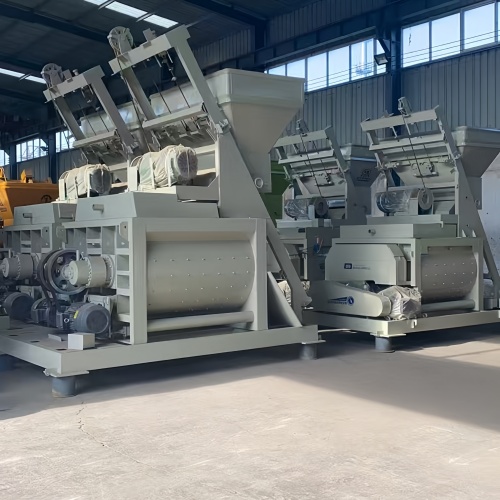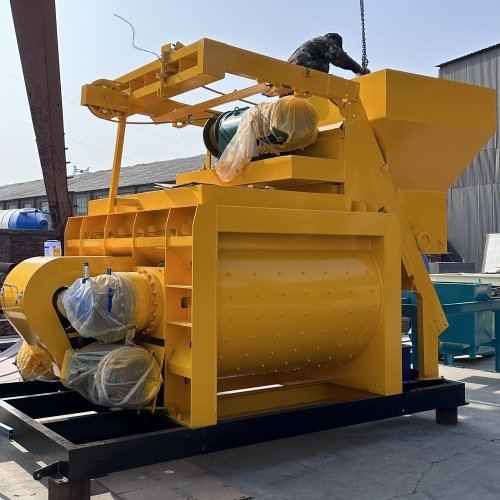Introduction: Understanding the Value Composition Behind the Price of a JS1500 Mixer
As the core equipment of medium to large mixing stations, the price composition of the JS1500 concrete mixer has always been a key concern for users. Market quotes for the JS1500 mixer range from ¥300,000 to ¥600,000, and such a wide price gap often leaves users confused. This article will provide a detailed analysis of the key factors affecting the price of the JS1500 mixer, offer the latest 2025 market insights, and give professional purchasing advice to help you make an informed investment decision.

1. Analysis of JS1500 Mixer Price Range (Latest 2025 Data)
1.1 Basic Configuration Price Range
According to 2025 market research data, the price of the JS1500 mixer is mainly divided into three tiers:
Economy Configuration (¥300,000–¥350,000):
- Uses domestically produced standard motors and reducers
- Standard steel thickness, basic welding processes
- Standard electrical control system
- Basic lubrication system
- Applicable for: Short-term projects or users with limited budgets
Standard Configuration (¥350,000–¥450,000):
- Uses motors from well-known domestic brands (e.g., Wannan, Nanyang)
- Planetary reducers, branded electrical components
- PLC automated control system
- Includes two 100T cement silos
- Applicable for: Most medium-sized engineering projects
High-End Configuration (¥450,000–¥600,000):
- Imported electrical components (e.g., Siemens, ABB)
- SICOMA or equivalent mixer units
- Fully automated intelligent control system
- Intelligent lubrication system
- Remote monitoring functionality
- Applicable for: Large engineering projects or high-standard requirements

2. Eight Key Factors Affecting the Price of a JS1500 Mixer
2.1 Core Component Configuration Level
Motor System:
- Standard domestic motors: Lower cost but limited efficiency and lifespan
- Domestic first-tier brands: Optimal cost-performance ratio, e.g., Wannan motors
- Imported brand motors: Stable performance but higher price
Reducer Type:
- Standard gear reducers: Lowest cost
- Cycloidal reducers: Mid-range price
- Planetary reducers: Highest transmission efficiency, most expensive
2.2 Wear Part Material Costs
Mixing Blades and Liners:
- Standard manganese steel: Lower cost, service life of about 6–8 months
- Alloy steel: 30% higher cost, service life extended to 1 year
- High-chromium alloy: 50–70% higher cost, service life up to 2 years
2.3 Automation Level Differences
Control system costs vary significantly:
- Manual control system: Lowest cost
- Semi-automatic control system: Mid-range price
- Fully automated intelligent control system: Highest cost but can save 30% on labor costs
2.4 Production Processes and Quality Control
- Standard manufacturing processes: Lower cost
- Robotic welding processes: 15% higher cost but more stable quality
- Heat treatment processes: Improves wear resistance, 10% higher cost
- Quality inspection system: Increases cost but ensures equipment reliability
3. 2025 Market Price Trend Analysis
3.1 Impact of Raw Material Prices
Raw material prices show an upward trend in 2025:
- Steel prices increased by 5–8% year-on-year
- Rising copper prices affect motor costs
- Wear-resistant material prices increased by 3–5%
3.2 Price Changes Due to Technological Innovation
- Smart upgrades increase high-end product prices by 5–10%
- Energy-saving technology increases initial investment but reduces operating costs
3.3 Market Competition Landscape
- Leading brands maintain stable prices, focusing on quality and service
- Small and medium manufacturers engage in fierce price competition, but quality varies
- Imported brands maintain high prices, mainly occupying the high-end market
4. Cost-Performance Evaluation and Purchasing Advice
4.1 Investment Return Analysis
Taking a standard-configuration JS1500 mixer as an example:
- Equipment investment: ¥400,000
- Daily output: 400 cubic meters
- Gross profit per cubic meter: ¥30
- Daily revenue: ¥12,000
- Investment payback period: Approximately 33 days (based on working days)
4.2 Purchasing Advice
Reasons to recommend the standard configuration (¥350,000–¥450,000):
1. Optimal performance-to-price ratio
2. Controllable maintenance costs
3. Ample spare part supply
4. Mature and reliable technology
5. Well-established after-sales service network
4.3 Price Traps to Avoid
1. Excessively low quotes: May use inferior materials or simplified processes
2. Hidden costs: Additional expenses such as transportation and installation
3.After-Sales Warranty : Low prices often mean reduced service
4. Spare part prices: Understand subsequent replacement costs
5. Additional Cost Budget Guide
5.1 Transportation and Installation Costs
- Domestic transportation: ¥20,000–¥50,000 (depending on distance)
- Installation and commissioning: ¥30,000–¥80,000
- Foundation construction: ¥50,000–¥100,000
5.2 Operating Cost Estimates
- Power consumption: ¥0.8–¥1.2 per cubic meter
- Wear part replacement: ¥0.3–¥0.5 per cubic meter
- Maintenance: ¥0.2–¥0.3 per cubic meter
5.3 Training and After-Sales Service
- Operator training: Usually included in the price
- Warranty period: Generally 1–2 years
- Emergency service: Confirm response time
6. Purchasing Recommendations
6.1 Purchasing Channel Selection
- Direct purchase from manufacturers: Best price, guaranteed after-sales service
- Purchase through agents: More localized service but possibly higher prices
- Online purchase: Pay attention to the inspection process to ensure the quality of the equipment
6.2 Acceptance Standards
- On-site testing: Ensure smooth equipment operation
- Material inspection: Verify material certifications for key components
- Performance verification: Test actual production capacit
Conclusion: Rational Investment, Focus on Long-Term Value
While the price of a JS1500 concrete mixer is important, it is even more crucial to consider the overall value of the equipment. We recommend that users:
1. Define requirements clearly: Determine configuration level based on production output requirements.
2. Compare cost-performance: Don't just focus on price; place greater emphasis on quality.
3. Consider long-term costs: Include energy consumption, maintenance, and spare parts, etc.
4. Choose reliable suppliers: Comprehensive after-sales service is essential.
5. Conduct on-site visits: Inspect production workshops to understand the manufacturing processes.
Investing in a JS1500 mixer is a significant decision. The right choice will not only ensure smooth production but also bring long-term stable returns. It is advisable to communicate with multiple suppliers before purchasing, conduct on-site inspections of production processes and quality control systems, and ultimately select the equipment that best suits your needs.
To obtain the latest JS1500 mixer quotations or personalized purchasing advice, please feel free to contact our professional advisory team. We will provide you with detailed technical consultation and cost-performance analysis services. With 20 years of industry experience, we have served over 500 companies, including large central enterprises like China Railway and China State Construction, and can offer you the most professional purchasing advice and comprehensive after-sales service.